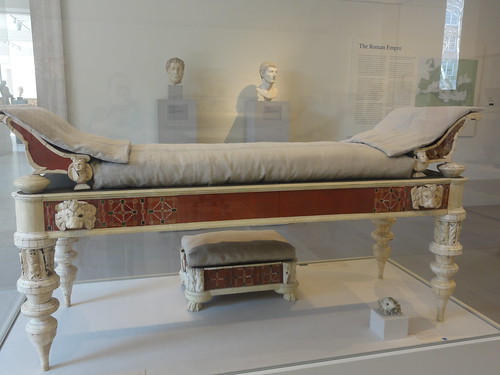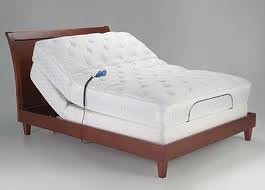THE HISTORY OF BEDS
INCLUDING INFORMATION ON ELECTRIC BEDS
“To sleep perchance to dream” (Hamlet)
 To sleep well is very important to good health and peace of mind.
One’s bed is not only a place of rest and sleep. It is a sanctuary, almost akin to the womb, where one somehow feels safe and sheltered from the busy world with all of its unwelcome intrusions. It is the only place where one is truly one’s self. A comfortable bed is the most valuable of all our worldly possession. To sleep rough on the streets or to be a soldier in a wet dug-out or ‘fox hole’ in some foreign field has to be a version of hell.
The building of a nest or bed is not the prerogative of Homo Sapiens. Most living creatures need to build a place of safety and refuge in which to regenerate and survive.
“The sparrow has found her an house, and the swallow where she may lay her young.” (Psalm 84)
Primates build nests. Orang-utans build new nests every day, high in trees, where they are safe from predators. The nest is usually built between ten and twenty metres off the forest floor. Having selected horizontal branches, they gather sticks and leaves for the construction. The more supple branches are bent inwards and woven together to form a “mattress”. Leafy branches are used to line the structure and sometimes a roof of branches covers the finished nest; the smaller softer leaf branches formed into a pillow. And so, the orang-utan is ready for bed; safe, warm, dry and free of Council Tax!
To sleep well is very important to good health and peace of mind.
One’s bed is not only a place of rest and sleep. It is a sanctuary, almost akin to the womb, where one somehow feels safe and sheltered from the busy world with all of its unwelcome intrusions. It is the only place where one is truly one’s self. A comfortable bed is the most valuable of all our worldly possession. To sleep rough on the streets or to be a soldier in a wet dug-out or ‘fox hole’ in some foreign field has to be a version of hell.
The building of a nest or bed is not the prerogative of Homo Sapiens. Most living creatures need to build a place of safety and refuge in which to regenerate and survive.
“The sparrow has found her an house, and the swallow where she may lay her young.” (Psalm 84)
Primates build nests. Orang-utans build new nests every day, high in trees, where they are safe from predators. The nest is usually built between ten and twenty metres off the forest floor. Having selected horizontal branches, they gather sticks and leaves for the construction. The more supple branches are bent inwards and woven together to form a “mattress”. Leafy branches are used to line the structure and sometimes a roof of branches covers the finished nest; the smaller softer leaf branches formed into a pillow. And so, the orang-utan is ready for bed; safe, warm, dry and free of Council Tax! |
| Image:flickr |
The history of beds is a fascinating social story. Beds not only reflect design and construction. They have been items linked to wealth, power and social custom. We always look at the Romans period as both an era of power and empire and also of ingenuity and technology. The Romans built cities, roads, palaces, baths and even central heating systems. For the rich Roman, a spectacular bed, covered with exotic textiles was a status symbol.
 |
| Image:flickr |
Viking beds did not have purpose made mattresses. Animal skins were used to make sacks. These would be stuffed with dry leaves, straw and even pea-pods. The result could not have been very comfortable! The Viking and Saxon words for bed and mattress give us a clear clue to the structure.
“Baence” (bench) and “streou” (straw). Interestingly, “crib” and “cot” originates from the same source and referred to more permanent sleeping platforms.
Viking bed frame
It is interesting to note that the wooden bed frame features the familiar Viking dragon shape more associated with Viking boat design.
 |
| Image:flickr |
 |
| Image:flickr |
Tudor Bedroom
The next major change in bed style and construction came about with the Victorians. Bed frames were made from metal which for the wealthier meant brass. The bed would be polished as part of the duties or those below stairs. After 1820, comfort was improved with a new innovation; mattresses with coiled springs. And so what of today? I suspect that in TV advertising, beds appear as often as any other product and more frequently than many. We see apparently never ending ‘sales ads’ featuring a range of couples leaping onto a mattress, strangely usually lacking sheets or duvets! Sleep is of course a vital part of our natural cycles. A lack of sleep reduces efficiency and results at best in a grumpy attitude and, at worst, to accidents. Motorway electronic signs spell out the warning – “Tiredness kills. Take a break.” No doubt we have all experienced times when for whatever reason we seem to have been awake all night. There are few worse experiences than lying there as the mind churns over with total mixed up nonsense. Sleeping problems can be experienced by those suffering illness, disability or simply the onset of ageing. It is during the night hat people feel at their lowest. Getting in and out of bed or finding the right sleeping position without those infuriating pillows sliding back can become difficult. There is an answer. Technology has afforded relief in the form of the adjustable bed. At the push of a button, the head section and other areas of the bed can be adjusted to suit the user’s needs, be it reading a book or sleeping elevated to assist breathing problems. Double beds are available for couples where the two halves of the bed can be adjusted individually.
 |
| Image:flickr |
There is little doubt that people with back or breathing problems need to be careful about the type of bed and mattress they sleep on. The disadvantage of a fixed bed, being a flat sleeping surface, is that they lack the ability to distribute pressure over the entire surface and tension of muscles and joints in often increased. There is also the possibility of putting strain on the heart and poor circulation. An adjustable bed may help. For some people sleeping surface, adjustable bed that is on an incline of say 30 to 45 degrees, may be more comfortable as the upper part of the body is higher than the lower part, similar to sitting in a chair. Some support under the knees may take away stress on the lower back. There is no one single bed type that suits everyone and it is important that a potential buyer tries out a bed before making a decision.
Conditions that may be helped by electrical adjustable beds:
- Lower back, neck and shoulder pain.
- Acid reflux
- Arthritis
- Asthma
- COPD
- Swollen legs or feet
- Some heart conditions.
How do electric adjustable beds work?
Watch this video to find out and come to Stoke on Trent to see one in our showroom at ST5 0HE.
So from orang-utans to sparrows and cats to Kings, we have devised ways to rest our weary heads. From bags of leaves to memory foam, from stately curtained four posters to electronic adjustable beds, our search for rest and relaxation is a daily requirement. Visit our Stoke on Trent electric bed showroom to find yours.
